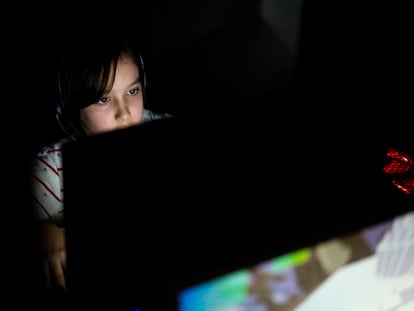The AI sexualization of the Vatican’s mascot and the limits of Rule 34: Everything on the internet can be ‘pornified’
Websites specializing in AI-generated images quickly sexualized Luce, the Catholic Church’s new anime-inspired character. It is the latest iteration of a growing problem with deepfakes as online tools become increasingly available

Any woman can be sexualized without her consent. If porn ever had any limits, however weak, artificial intelligence (AI) has destroyed them all. The first victims were celebrities, but the targets have been extended through the proliferation of fake creations with a lifelike appearance (deepfakes) with tools whose availability has multiplied by 40 in just a year and a half, according to the United Nations. These days, any politician, neighbor, classmate or co-worker can see their image violated. One of the latest victims is not even real. It is Luce, an anime-inspired character created by the Italian designer Simone Legno, co-founder of Tokidoki, and meant to represent a young pilgrim at the Catholic Church’s upcoming Jubilee (Holy Year) celebrations. In less than 24 hours, AI image creation websites have turned the character into a sexual icon, claiming that, according to the unofficial “Rule 34” of the internet, “anything can be pornified.”
The Vatican’s intentions were immaculate. It presented its mascot Luce (meaning “light” in Italian) on October 30 at the opening of the Holy See Pavilion at next year’s Expo in Osaka (Japan) as a “symbol of hope and fraternity” for young people, according to Archbishop Rino Fisichella, organizer of the Jubilee. But in less than 24 hours, websites specializing in AI-generated images opened Luce’s yellow raincoat (the color of the Vatican flag) and stripped her of her mud-stained boots, leaving her only with her Catholic symbols and subjected to all kinds of pornographic recreations.
“Women are the canaries in the mine when it comes to AI abuse. It’s not just going to be the 14-year-old girl or Taylor Swift, it’s going to be the politicians, the world leaders, the elections. We are too few and too late, but we can still try to mitigate the disaster that is unfolding,” warns Mary Anne Franks, a professor of Intellectual Property, Technology, and Civil Rights Law at George Washington University and president of the Cyber Civil Rights Initiative.
Real-world cases have proved her right. A website that constantly compiles AI incidents lists up to six British female politicians who have been victims of deepfake pornography over the years. The Democratic candidate for the U.S. presidency, Kamala Harris, has her own categories on the same site that has sexualized the Vatican mascot and become the target of online violence.
There is a sexualization of women on the internet, a resurgence of sexist behavior, a return to an instrumental conception of them as pure objects of pleasure at the service of men, in a spiral that should be extremely worrying and motivate strong reactionsRicard Martínez, Chair of Privacy and Digital Transformation at University of Valencia
But it’s not just politics. The same record of complaints about AI abuse reveals a trail of young girls stripped by their classmates in school, based on real images posted on social media. And the victim could be anyone, from a neighbor to a work colleague.
The problem is so big that the UNFPA, the United Nations’ sexual health and reproductive rights agency, has a specialized unit on technology-facilitated gender-based violence (TFGBV). Alexandra Robinson is one of its advisors and warns: “The number of AI tools available to create deepfakes has increased from five to 200 in the last 18 months, indicating that these technologies and the non-consensual sharing of synthetic images are increasingly being used in the perpetration of gender-based violence in the workplace.”
“Creating a 60-second deepfake pornographic video of anyone using only a clear facial image takes less than 25 minutes and costs zero,” Robinson explains. The victims, he details, are women in 99% of cases and in all areas.
In this regard, Alexandra Robinson draws attention to the extent of the problem: “Non-famous people are targets of online gender-based violence. Wherever technology is available, a space or tool is created through which violence can be perpetrated.” This is supported by a 2021 study that raises to 85% the number of women worldwide who have witnessed or experienced (38%) online violence, mainly racialized people, the LGTBIQ+ community, politicians, young people, human rights activists and journalists, according to the CNN As Equals and Plan International survey.
In all cases, the aim is sexual violence through objectification, denigration, violation of the right to one’s own image, intimidation and even extortion. But when the victim is a politician, there are also attempts to silence and damage her personal reputation, while at the same time, according to Robinson, “eroding trust in democratic institutions by using gender disinformation to dissuade women from participating in politics.”
The controversial “Rule 34” of the internet
The website with the most derogatory recreations of the Catholic mascot claims to be protected by a popular “rule” of the internet, called “Rule 34”: “If something exists, it can be porn-ified.” This is complemented by the warning that if there is something that has not been turned into porn yet, it will be.
Ricard Martínez, Chair of Privacy and Digital Transformation and professor at the University of Valencia, strongly refutes this: “No image can be sexualized without consent, even if it is specified that it is a recreation. Each and every one of us has the right to our own image, to a private life and to our honor. In digital environments, we must understand this from a practical and material point of view. Using someone’s image without permission to sexualize them constitutes illicit behavior.”
Martínez believes that this involves the entire spectrum of derogatory content, even those that hide behind the spirit of “animus iocandi,” cartoons with a humorous or joking intent.

The legal expert says that the sexualization of the Vatican mascot falls within this remit: “It is obvious that the mascot is protected by intellectual property rights, but that is not the only issue. If you take a mascot that is the official emblem of an activity that, in this case, is also of a religious or social nature, and you sexualize and ridicule it, on the one hand you are altering an image that is subject to intellectual property; but in addition, from a material point of view, it’s not the mascot that is sexualized, but also what it represents. In this sense, the infringement of rights goes much further and directly impacts the rights of the group it represents.”
In the case of the pornification of women in the political sphere, there is a difference between the exercise of freedom of expression to contribute to the creation of a free public opinion and sexualization. “We are talking about conduct that harms their public image, their honor and their privacy and, in addition, seriously harms and humiliates them in an instrumental way. Additionally, a multiplier effect is produced: as with the mascot, we are not only sexualizing the person or character but everything that they represent,” he warns.
Like Alexandra Robinson, the U.N. advisor, and Anne Franks, the George University professor, Ricard Martínez warns about the “devastating effect on political and civic coexistence.” “The obvious intention is to polarize public opinion and generate alterations in the public and constitutional order. Therefore, there is a further danger of generating systemic risks for democracy,” he explains.
In this way, deepfakes are not just a creative tool, but also criminal in many cases. And to avoid this, Martínez not only invokes individual responsibility, urging more digital and sexual education, but also accountability for platforms that provide digital services that facilitate their creation and dissemination, and which are obliged by law to proactively analyze and prevent these practices.
“There is a sexualization of women on the internet, a resurgence of sexist behavior, a return to an instrumental conception of them as pure objects of pleasure at the service of men, in a spiral that should be extremely worrying and motivate strong reactions,” he concludes.
Robinson agrees: “There are several ways to change violence against women online. Firstly, through legislation and policy [she highlights Australia’s eSafety], but also through a greater focus on digital literacy and safety enforcement.”
She also points to tools like StopNCII, which allows anyone to track and delete non-consensual intimate images, “cleaning up your digital profile to ensure they can’t be traced back to you, including social networks of friends and family.”
Sign up for our weekly newsletter to get more English-language news coverage from EL PAÍS USA Edition
Tu suscripción se está usando en otro dispositivo
¿Quieres añadir otro usuario a tu suscripción?
Si continúas leyendo en este dispositivo, no se podrá leer en el otro.
FlechaTu suscripción se está usando en otro dispositivo y solo puedes acceder a EL PAÍS desde un dispositivo a la vez.
Si quieres compartir tu cuenta, cambia tu suscripción a la modalidad Premium, así podrás añadir otro usuario. Cada uno accederá con su propia cuenta de email, lo que os permitirá personalizar vuestra experiencia en EL PAÍS.
¿Tienes una suscripción de empresa? Accede aquí para contratar más cuentas.
En el caso de no saber quién está usando tu cuenta, te recomendamos cambiar tu contraseña aquí.
Si decides continuar compartiendo tu cuenta, este mensaje se mostrará en tu dispositivo y en el de la otra persona que está usando tu cuenta de forma indefinida, afectando a tu experiencia de lectura. Puedes consultar aquí los términos y condiciones de la suscripción digital.
More information
Archived In
Últimas noticias
Most viewed
- Oona Chaplin: ‘I told James Cameron that I was living in a treehouse and starting a permaculture project with a friend’
- Reinhard Genzel, Nobel laureate in physics: ‘One-minute videos will never give you the truth’
- Sinaloa Cartel war is taking its toll on Los Chapitos
- Why the price of coffee has skyrocketed: from Brazilian plantations to specialty coffee houses
- Silver prices are going crazy: This is what’s fueling the rally










































